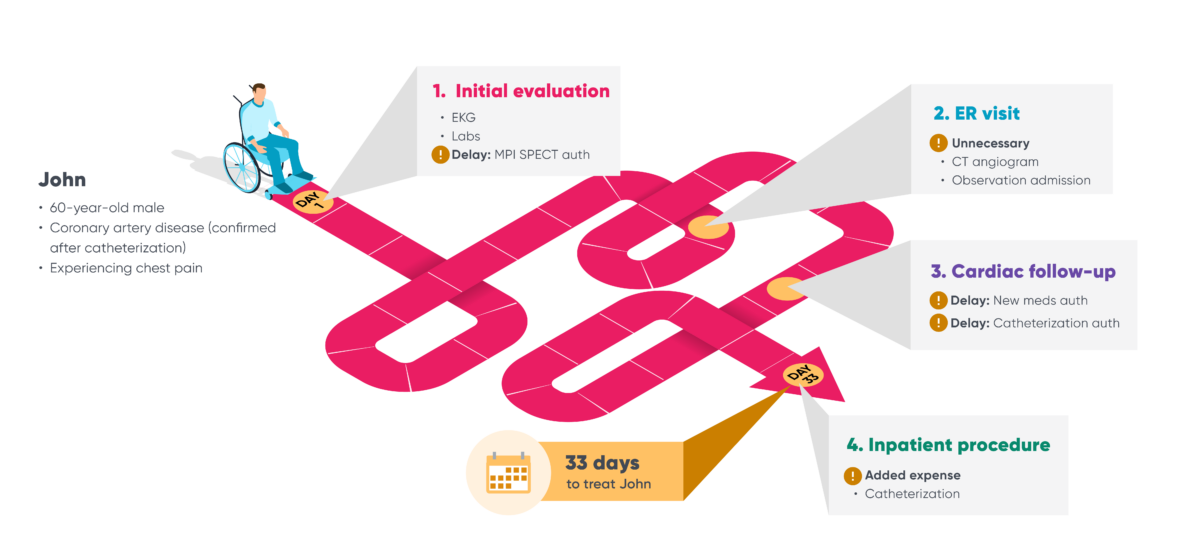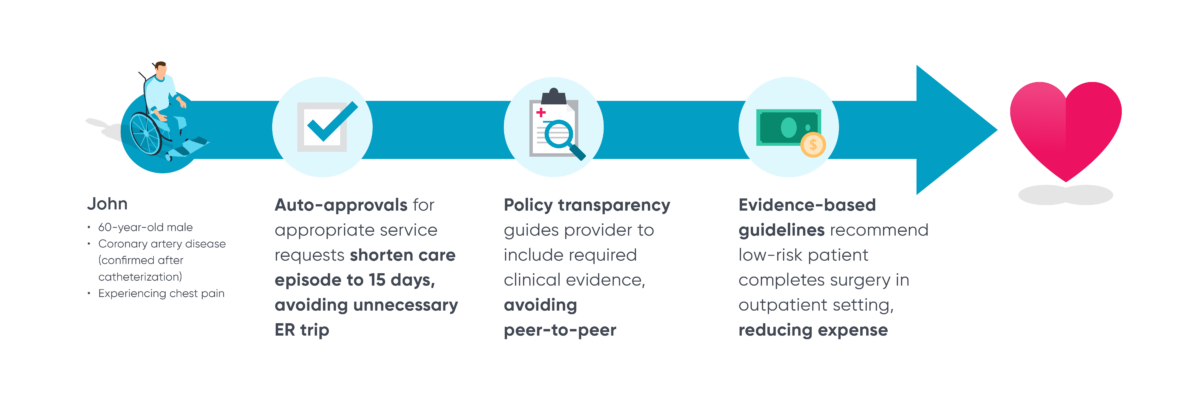Prior authorization, while essential to ensuring safe, appropriate care for members, is frustrating for patients and providers. Health plans can use a care path approach to ameliorate some of the stressors identified in research conducted by the American Medical Association (AMA), such as:
- 88% of physicians describe the burden associated with prior authorization as high or extremely high
- 94% of physicians report care delays associated with prior authorization
- 80% of physicians report that prior authorization can at least sometimes lead to treatment abandonment
- 31% of physicians report that prior authorization criteria are rarely or never evidence-based
The transactional nature of prior authorization requests and interoperability issues can result in decisions that don’t always consider the patient’s longitudinal history. Patients and providers must wait for requests to be approved, sometimes even for routine testing and medication changes. In some cases, physicians may have to schedule and conduct a peer-to-peer review in order to secure approval.
In this article, you will learn:
Why care paths are changing the landscape of prior authorization
Intelligent prior authorization addresses these friction points by removing interoperability barriers and adding clinical context to each prior authorization decision. As an integral component of intelligent prior authorization, care paths are built using a combination of widely accepted evidence-based clinical policy and historical patient cohort claims data, leveraged by AI and machine learning.
By accessing clinically contextual information about the patient and comparing it to prior authorization data from patient cohorts with similar clinical situations, intelligent prior authorization orients transactional service requests within a more longitudinal context.
The ultimate result? Care that is better, faster, and safer than a simple “yes or no” prior authorization approach.
These care paths:
- Drive better results from value-based care programs
- Reduce care variation by enabling proactive care collaboration across the patient care journey
- Maintain or increase the cost-of-care savings while reducing care denials and provider friction
- Generate optimal, patient-specific care by leveraging cohort data and predictive, AI-assisted analytics
Care paths transform the patient and provider experience for a cardiology patient
For a 60-year-old male patient experiencing chest pain, being placed on a chest pain care path can reduce the length of his care episode from 33 days to 15 days.
Without the benefits of prior authorization, this patient has four visits: the first is for an initial evaluation, where he gets an EKG and some labs done. His physician orders an MPI-SPECT, but due to prior authorization, there’s a delay before it can be approved. Frustrated after a week without treatment, the patient visits the emergency room, where he receives a CT angiogram and is kept under observation for the night.

The next week, he goes in for a follow-up appointment with his cardiologist, who recommends he begin a new medication (which also requires prior authorization) and orders a catheterization. Due to missing clinical criteria required by health policy, the catheterization is escalated to a peer-to-peer review before being approved, adding another week to the patient’s timeline. Thirty-three days later, the patient finally undergoes the procedure (in an inpatient setting) and verifies a coronary artery disease (CAD) diagnosis.
With the advanced technological capabilities of intelligent prior authorization, this cardiology patient’s care episode can be streamlined and condensed to cut down the burden on both patient and provider.

When the patient first experiences chest pain, their initial appointment resembles the original visit, including both an EKG and labs. However, when the physician requests authorization for an MPI-SPECT, it is immediately approved via automated decisioning, allowing the patient to schedule a follow-up appointment for the next week before leaving the office. Since the patient feels that her needs are being met, the ER trip from the original episode is avoided, saving both the health plan and the patient money.
During the follow-up appointment, the physician’s order for a new medication is also immediately approved so that the patient can start it that day. Intelligent prior authorization clearly states policy requirements for approval and alerts physicians when required information is missing. Therefore, the patient’s physician includes the policy’s required clinical evidence for a catheterization, avoiding the burdensome peer-to-peer review. While submitting the authorization request, the physician is also prompted to consider an ambulatory surgery setting for the patient’s procedure. This lower-cost alternative is convenient for patients and reduces expenses for the health plan. Once submitted, the request is immediately approved, and the patient receives a CAD diagnosis 15 days after experiencing chest pain.
Care paths help the health plan-provider relationship by promoting evidence-based guidelines, optimizing moments of influence, and encouraging physician collaboration.
Four ways clinical innovation solutions are working together to enhance the power of care paths
Care paths are clinical innovation, which use a combination of AI and machine learning with deep, evidence-based clinical expertise to influence the end-to-end patient journey.

These solutions are data-driven and evidence-based; they apply clinical intelligence to health plan data using care paths as a way to isolate different patterns and results for patient populations. Health plans can use the prior authorization transaction as a lever to improve care quality and reduce medical expense. Here are a few examples of how:
1. Proactively leverage health plan data to improve clinical quality and outcomes using trend management
Health plans can use clinical information and prior authorization history to form patient cohorts and use these groups to monitor and improve interventions and care journeys.
2. Lower total cost-of-care trends for implemented care paths with policy optimization
Clinical innovation solutions leverage AI and machine learning to compare health plan prior authorization and patient outcome data to benchmarks and identify opportunities for medical expense savings by targeting overutilization.
3. Reduce administrative burden and clinical variation by bundling a portion of a care path’s services with episodic authorizations
Artificial intelligence and machine learning apply a combination of health plan data and evidence-based guidelines to inform ideal service pairings to drive better outcomes. For example, episodic authorization could group cardiac rehabilitation services with an invasive procedure. In-workflow nudges encourage provider alignment with high-value care pathways, bypassing the need for a provider to submit more than one authorization. This intervention brings the patient into the plan of care, notifying them of accompanying services for which they are already eligible.
4. Leverage provider performance data to improve care path efficiency using network intelligence
Using provider performance metrics (including facility or individual level), health plans can isolate high- and low-performing providers and address areas of concern to reduce variation from evidence-based care pathways. Making this data readily available to providers and opening conversations about high-value alternatives fosters transparent, collaborative relationships between health plans and their provider partners.
Want to learn more about how care paths are influencing patient journeys? Download our Care Path Playbook.